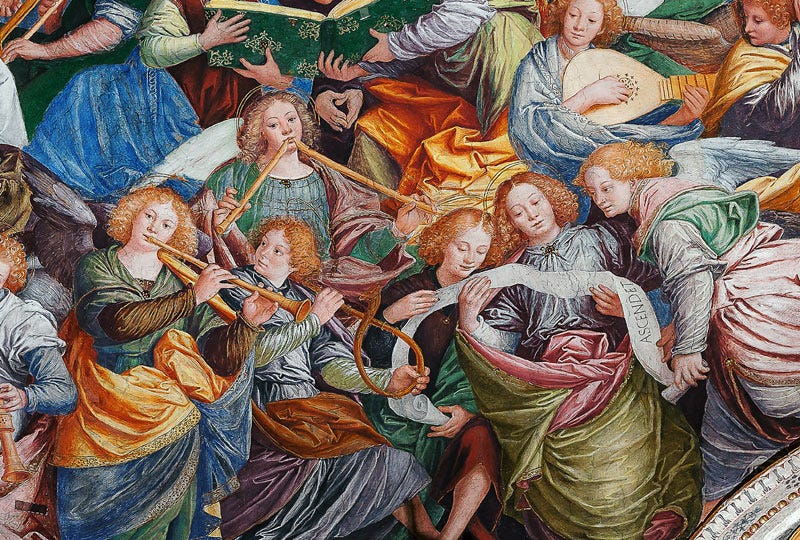I started reading words in about 1984 and music in about 1986, which is to say that by the time I was old enough to crack open any hymnal in sacrament meeting, it was the 1985 Green Book that I was opening. I didn’t think of it as the new book, which it was. I thought of it as the only book. I assumed that whatever was in there had probably been in there forever—a little like when my family moved into a new neighborhood in 1987, seven-year-old me assumed that everyone there had always lived there.
Granted, some of the contents of the Green Book were indeed quite old. For example, the text for “O Savior, Thou Who Wearest a Crown” began in the medieval Latin poetic text Salve mundi salutare (though it was altered substantially, not just translated, for our hymnal), and the music made its way from Hans Leo Hassler (1564–1612) through J. S. Bach (1685–1750) through various and now effectively anonymous arrangers into the chorale harmonization we Latter-day singers know.
Meanwhile, it turned out that some of the Green Book Top 40 are only about as old as I am and written by people I know, meaning that these musical lauds weren’t eternal like God, timeless like chant or carols, or even just plain old like so many of the Victorian nuggets we’ve collected. For instance, I realized that the music for “Press Forward, Saints” (with the magical, “modally borrowed” chord that sets “Al-LE-LU-ia” apart from the rest of the text) was composed by my very own, beloved and loving, elementary school choir teacher, Vanja Y. Watkins (1938–). Similarly, I discovered that the music for “Lord, I Would Follow Thee” was composed by K. Newell Dayley (1939–), for whom I worked as a teaching assistant when I was an undergraduate music student at BYU.
The fact that these texts and tunes came from somewhere, that they were created by actual people nearly as ordinary as I am, took a long while to sink into my creative awareness. Over time I came to appreciate and admire the poets, lyricists, tunesmiths, and composers who expressed their personal devotion and spirituality through their consecrated creative work. The 2018 announcement that the Church would update the great Green Book itself moved hundreds, maybe thousands, of Church members to funnel their personal devotions and feelings into text and music, and it caused me to wonder why I hadn’t done the same.
Despite having written quite a bit of music, including a fair amount of commissioned liturgical music for other denominations, I hadn’t ever really used my craft to serve my own tradition, and certainly not to express my personal devotional sentiments. Perhaps I felt that, despite our theological attachment to an open scriptural canon, our culture had come to accept something like a (tightly) closed musical canon—after all, if it wasn’t in the Green Book, our congregations essentially didn’t sing it. Simultaneously, the pragmatic professional composer in me did the math: few LDS congregations spend much money on music, and in the digital era, what used to be the tiny “Mormon music” market had become even tinier, even less viable. I can't think of a “professional” argument for writing LDS hymns.
The Church’s deadline for hymn submissions came and passed, and my skepticism and reservations had hamstrung my own participation.
Finally, I found myself on a flight to the London Festival of Contemporary Church Music, where I would network with music directors and vocal ensembles who perform my music. I wondered: What kept me from using my creative skills in service of my own tribe, when I was willing to fly so far away to make music for other tribes? Something shifted as the plane bumped through the air, and I remembered “Sister” Watkins, who had recruited my sister, brother, and myself from our elementary school choir to sing on the Church’s early 1990s recordings of the Children’s Songbook. She had communicated something like “pure religion” through her ebullient eyes and radiant smile as we rehearsed and recorded hundreds of songs, some of which she had written.
I assume—that is, I hope—the roar of jet engines covered my spontaneous humming and vocalizing as I scratched out three verses of text, reflecting my desire to grow as a disciple, and a melody that struck me as artful but plain, not quite Appalachian but intuitive and singable (with a little Renaissance-era compositional trick at a key moment). Later I worked out a four-voice harmonization that pleased me and, to my ear, supported the feeling of the text, taking a page from Sister Watkins’s own playbook in employing a distinctive “modally borrowed” chord in the final phrase.
Ultimately, all hymns, no matter how old or venerable, come from somewhere, and unless they were a sonic transcription of the music of the spheres, they came from somewhere inside someone. And this one comes from me out of a growing desire to connect my faith to my craft, sparked by a memory of a loving mentor who pressed forward in doing the same.
Andrew Maxfield is a composer based in Provo, UT, whose “rhythmically vital . . . superbly judged . . . tender” works (Fanfare Magazine) have been performed by The Gesualdo Six, The Choir of Royal Holloway, Salt Lake Symphony, Utah Opera, and others.
Art by Gaudenzio Ferrari.




